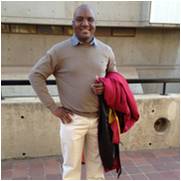2016 New Investigator: Ntakadzeni Edwin Madala

 Nominee:
Nominee:
Nominated By:
Supporting Comments:
What made you choose a career in bioanalysis?
The field of metabolomics is fascinating, especially more when one imagines that over thousands of molecules can be analyzed simultaneously, though there is still no single analytical technique (regardless of its robustness or sensitivity) sufficient enough to cover a single metabolome. This complexity on the metabolome level, led me to believe that we are still far from understanding the metabolite functions. To achieve the latter, I started developing techniques capable of answering some of the long standing questions, such as how can one analytically distinguish between biologically relevant isomers and subsequently deduce the biological functions thereof?
Describe the main highlights of your bioanalytical research, and its importance to the bioanalytical community.
After three years working with some of the most abundant poly-phenolic compounds known as chlorogenic acids, we (collaborating with Profs I Dubery and P Steenkamp) have developed a very sensitive and accurate mass spectrometry method of distinguishing the geometrical isomers thereof. To date, geometrical isomers of chlorogenic acids could only be distinguished through the use of chromatographic elution order. However, due to unstandardized column manufacturing, different orders of elution can be achieved which in most cases resulting in erroneous identification. With this newly developed in-source collision induced dissociation (ISCID) MS method, the geometrical isomers of these molecules could be distinguished for the first time. Since these isomers result in the same MS fragmentation patterns, our method relied on alkali metal adduct formation as a way to distinguish between the cis and trans isomers. Here, the cis isomers of dicaffeoylquinic acids were shown to form stronger and more abundant adducts than their trans counterparts. Our method was further validated by the use of density functional theory models. To date, we have validated our method using real biological samples and we have discovered astonishing evidence suggesting that there could be a biological bio-synthetic origin of the cis isomers of chlorogenis acids in plants, something which was not previously known in the scientific community.
What is the impact of your work beyond your home laboratory?
Recently I reviewed a paper to be published in International Journal of Mass Spectrometry where the authors based their arguments on our previous findings where we showed a biological perturbation of cis isomers (for the first time) in plants. In 2014, an editor of the Journal of Physiological and Molecular Plant Pathology wrote an editorial article entitled “Chlorogenic acid: A versatile defense compound” based on an article we published in the same journal. In our paper we identified these molecules using our ISCID method to be the central molecules during plant defense priming. In his editorial, the editor cited our work comprehensively, suggesting the impact of our findings. Moreover, the pioneer of chlorogenic acids analysis, Prof Mike Clifford (Surrey University, UK) also expressed his appreciation of our work on isomer differentiation through personal communication. Restek International also awarded us a grant of $3000 to use their columns in our work on isomers differentiation.
Describe the most difficult challenge you have encountered in the laboratory and how you overcame it.
The most challenging situation which we constantly encounter is access to some of the instrumentation such as ion-mobility mass spectrometry. The work on isomers requires very dedicated instruments such as sensitive NMR and MS. Another challenge is the availability of qualified/skilled students and collaborators. For instance, I am a biochemist by training and had very limited chemistry training as an undergraduate student and most of the concepts I acquired through self-study. The same can be said about some of our graduate students who battle to execute some of these projects due to lack of sufficient training. To overcome the first obstacle (instruments availability), collaborations were initiated with some international laboratories such as the Pacific Northwest National Laboratory in the USA who are on the forefront in ion mobility MS. Secondly, I have initiated some collaboration with quantum chemists around the country to help with explanation of some of our findings in order to reach a wider audience. Moreover, I also send some of my students to spend some time in chemistry laboratories to learn some chemistry modelling which is mandatory to explain their results. Attending international conferences is another good way of getting feedback on our approaches.
Describe your role in bioanalytical communities/groups.
Our group (under the leadership of my PhD supervisor, Prof. Ian Dubery) was awarded the ‘Chromatographer of the Year’ award by the Chromatography Society of South Africa (CHROMSA) in the year 2014. This came as recognition of our continuous involvement and advancement of chromatography in South Africa. Thereafter, we became very vocal members of this association and have been involved positively in organizing seminars on chromatography here in the Gauteng province of South Africa. Whenever there is a call, our graduate students are always encouraged to attend and share their knowledge with other students from under-privileged institutions. Our active research in MS-based metabolomics, also saw me being appointed as a representative in the South African Association of Mass Spectrometry (SAAMS) as a metabolomics representative (http://info259309.wix.com/saams#!our-committee/c6mv) in the year 2015. I am also an active member of the Moringa Development Association of South Africa (MDASA) and my role is to help farmers to substantiate their farming practices using scientific data. To the best of my knowledge, we are in position of the largest chemical database of Moringa metabolites from plants collected around the whole world and through associations with institutions such as MDASA, this data is shared with the rest of communities through local radio stations.
Please list up to five of your publications in the field of bioanalysis:
- Mhlongo MI, Piater LA, Steenkamp PA, Madala NE, Dubery IA*. Metabolomic fingerprinting of primed tobacco cells provide the first evidence for the biological origin of cis-chlorogenic acid. Biotechnology Letters. 37(1), 205–209 (2015)
- Mhlongo MI, Piater LA, Madala NE, Steenkamp PA, Dubery IA*. Phenylpropanoid defences in Nicotiana tabacum cells: Overlapping metabolomes indicate common aspects to priming responses induced by lipopolysaccharides, chitosan and flagellin-22. PloS One.11(3), e0151350 (2016).
- Madala NE*, Tugizimana F, Steenkamp PA. Development and optimization of an UPLC-QTOF-MS/MS method based on an in-source collision induced dissociation approach for comprehensive discrimination of chlorogenic acids isomers from Momordica plant species. Journal of Analytical Methods in Chemistry. 2014 (2014).
- Mhlongo MI, Piater LA, Steenkamp PA, Madala NE, Dubery IA*. Priming agents of plant defence stimulate the accumulation of mono-and di-acylated quinic acids in cultured tobacco cells. Physiological and Molecular Plant Pathology. 88, 61–66 ( 2014).
- Makola MM, Steenkamp P, Dubery IA, Kabanda MM, Madala NE*. Preferential alkali metal adduct formation by cis geometrical isomers of dicaffeoylquinic acids allows for efficient discrimination from their trans isomers during ultra‐high‐performance liquid chromatography/quadrupole time‐of‐flight mass spectrometry. Rapid Communications in Mass Spectrometry. 30(8),1011–1018 (2016).
Please select one publication from above that best highlights your career to date in the field of bioanalysis and provide an explanation for your choice.
I would say publication number 5 by Makola et al. (2016), the reason being that in this paper we were able to answer a very long standing problem of distinguishing between geometrical isomers of plant phenolic compounds. The findings of this paper are expected to help scientists across the whole world to be able to identify these compounds with confidence. This will also help a great deal in assigning biological functions of some of these compounds. As such, the findings of this publication are expected to provide an analytical template for future related studies.
Find out more about this year’s New Investigator Award, the prize, the judging panel and the rest of our nominees.



